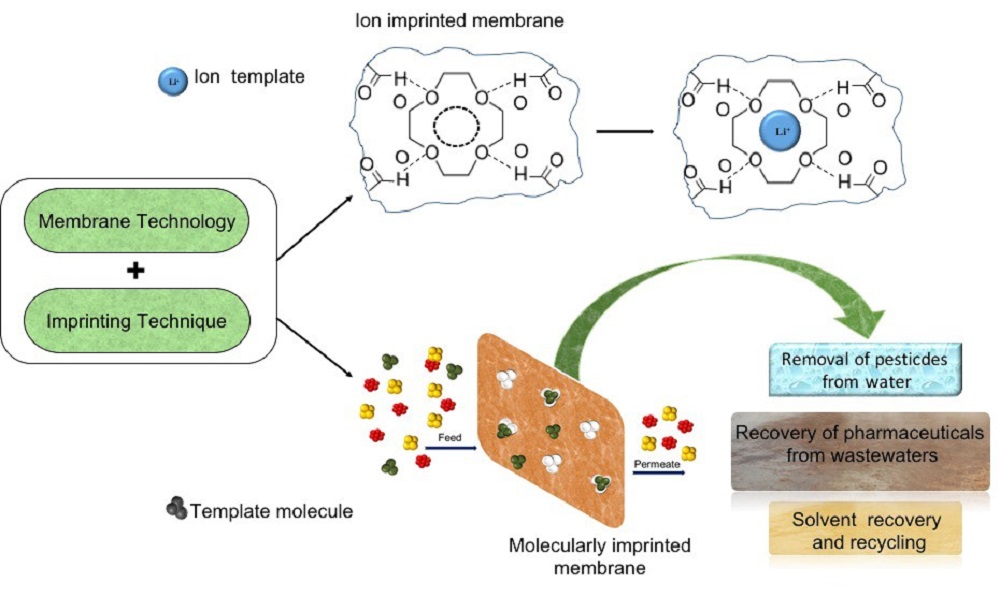In another work, high selective Li-IMs with crown ether were produced using PVDF (modified with a thin layer of polydopamine) as membrane forming material [
117]. During the imprinting process, crown ether formed a stable complex with Li
+ and therefore promoting the formation of Li-complementary recognition sites on the IIM surface. Binding tests showed high adsorption capacity of Li
+ in the presence of Mg
2+. The maximum selectivity factor (4.42) was observed at high initial ions concentration. In addition, permeation tests in a diffusion cell evidenced low lithium permeation, confirming that the absence of specific interaction between the Li-imprinted membrane and Mg
2+ promoted its fast permeation. Membranes were regenerated six times without losing their performance. Nanocomposite [
118], hybrid [
119,
120] and zwitterion [
121] Li-IIMs have been also produced. Recently, Wang and co-workers used the cup-like oligomer calixarene as ligand for preparing dual-imprinted mesoporous films applied in the simultaneous separation of lithium and rubidium from other mono and divalent cations. The separation mechanism was based on the selective adsorption of the two template ions [
122]. This work demonstrated that it is possible to realize the selective separation of different ions simply changing the internal size of the oligomer. In the last years, IIMs for the selective recognition of transition metals have been also produced by using different strategies. In 2014, Du and co-workers prepared composite film made of ferricyanide embedded conductive polypyrrole for the selective electrochemical removal of nickel (II) from wastewater [
123]. Nickel is a heavy metal ion that owing to its human toxicity needs to be removed from the environment. Composite membranes exhibited a Ni
2+ adsorption equilibrium time less than 50 s. The maximum ion exchange capacity for the uptake/release Ni
2+ removal from water samples was 1.298 mmol·g
−1. Separation factors Ni
2+/Ca
2+, Ni
2+/K
+, and Ni
2+/Na
+ were of 6.3, 5.6, and 6.2, respectively. Previously, Ni
2+-IIMs were also produced by copolymerization of methacrylic acid as functional monomer and dithizone as ligand on the surface of PVDF membranes [
124]. In this case, IIMs showed a specific perm-selectivity of the targeted ion, separating it from water solution also containing the competitive cobalt ion (Co
2+). The separation factor Ni
2+/Co
2+ was 2.6. Recently, Zeng et al. [
125] proposed an advanced strategy in preparing Ni-imprinted membranes. Authors synthesized an ion imprinted polymer using silica gels. Subsequently, this polymer was used to create a dynamic membrane on the surface of a ceramic membrane. Imprinted dynamic membranes resulted more stable than original ceramic membranes. Furthermore, they had a higher permeate flux and Ni
2+ rejection, allowing its efficient removal from water [
125]. Another example of imprinted transition metal is Cupper Cu
2+. This element is largely present in the industrial wastewater and can be present in excess in drinking water. It is toxic for liver and stomach and can causes intestinal and other health problems. Therefore, it is important to remove it from these matrices because the copper is non-biodegradable and can accumulate in the food chain [
126]. In 2018, ion imprinted membranes for the removal and recovery of Cu
2+ from water were prepared by applying an advanced immobilization method entailing the preparation of polymerizable chelating monomer divinylbenzyl triethylenetetramine, the formation of complex Cu-functional monomer, the subsequent polymerization/cross-linking of the complex within the pores of a PVDF-based membrane [
127]. The recognition performance of the membranes were evaluated by performing adsorption and permeation tests as well as selectivity studies with mix solutions of Cu
2+ and Ni
2+. The maximum copper adsorption (64.4 mg·g
memb−1) was observed at pH 6.0. At this pH, the amount of the cation adsorbed by the IIM was about of 4 times greater that the valued measured for the corresponding non-imprinted membrane. In addition, the permeation amount of Cu
2+ through the imprinted membranes was higher than that of Ni
2+. This study demonstrated the possibility of separating Cu
2+ from industrial wastewater containing Ni
2+ [
128]. Cu-imprinted membranes were also prepared
via surface imprinting [
128–
131]. IIMs have been also prepared for the selective recognition of other metals ions such as Rh
3+, Pt(IV), Pb
2+, Hg
2+, Cd
2+, Ag
2+, etc. The related literature reports detailed information [
132–
139].














